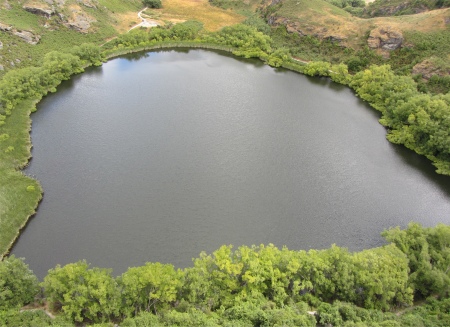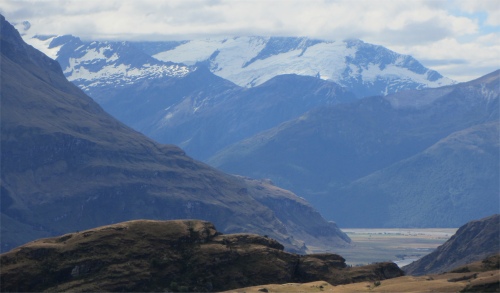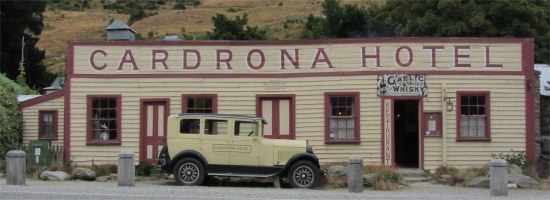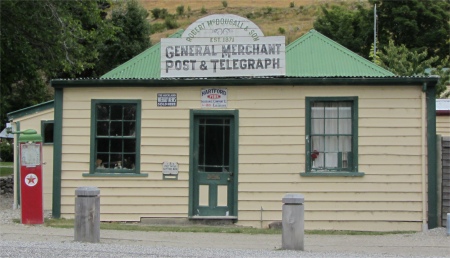For the next fifty years the valley was the domain of the merino sheep industry and became a quiet backwater.
I called in on the Cardrona Hotel for a coffee. It still stood in its high lands setting, clad in weatherboards and veranda. This was an archetypical icon, and featured in many adverts for beer. It had recently been extended, but the workmanship was good enough to convince most visitors that it was all the original building. As I waited for my coffee, I stood by a roaring log fire to thaw out, as did most people who visited the old building. The walls, the colour of ancient smoke stains, were liberally coated with fading old photographs and paintings, and memorabilia abounded on all flat surfaces. The burnt umber ceiling had notes of every currency under the sun stuck to it, and a fair collection of coins too.

Diamond Lake
|
The Cardrona Hall nearby was built in 1879 as the local school. Children from miles around used to attend, often on ponies which were left in a nearby paddock during school hours. It operated until 1954 when dwindling numbers caused its closure.
The small church near to it had a much more chequered history. Even older than the hall, it began life as the miners recreation hall, an annex attached to the All Nations Hotel across the river. It was used for dances, billiards and social events. After the All Nations burned down, it was acquired by a Mr Enright, a devout local catholic, who had it consecrated as the Cardrona Catholic Church. It had been relocated in its time, and remained in use until 1985, when it was replaced by a new church. It was on the eve of its destruction as the fire brigade practice, that the Cardrona Valley residents purchased it and had it shifted to its current resting place. It has now come full circle, and is once again used as the local pool and darts venue, as well as for small parties and concerts.
Suitably revitalised by my first coffee of the day, I headed down to Lake Wanaka, passing the detritus from the gold-mining heyday, strewn across the valley amongst the golden tussock. Wanaka, sat by the pretty Roys Bay area on the south of the lake, adjacent to the outflow to the Clutha River. This gateway to Mount Aspiring National Park had a more laid-back feel compared to its brasher southern sibling of Queenstown. Wanaka is primarily a resort town and is one of the few areas in New Zealand to enjoy a continental climate, with four distinct seasons. The weather is fairly dry with spring (September-December) being the wettest months. Annual rainfall is 682 mm which is half the national average. The town experiences hot dry summers with temperatures reaching the high 30s but the average is 24�C. Winter tends to have clear calm days with highs around 10�C. Due to the growing tourism business and the increasing number of retirees in Wanaka, there is massive growth occurring, up to 50% in 10 years.

Rob Roy Glacier in Mount Aspiring National Park
|
I had no trouble getting into the nearest campsite to town, despite warnings that it would be full at this time of year. The site was less than 100m away from the stunning view over Lake Wanaka. The 45km-long glaciated lake, nestled between the dramatic peaks of the national park, and the poplar-studded hills of Central Otago, and reminded me very much of the English Lake District.
The exploratory walk around Wanaka took me around 30 minutes, and the art galleries took another 30.
I needed to stretch my legs, so I headed up Mount Aspiring Road, parked up, and set off to Diamond Lake. This was a delightful tarn left over from the last ice age, and surrounded by willows and raupo rushes. The track skirted the tarn for a short way before veering off and climbing a narrow trail into open farmland speckled with brown bracken and home to a herd of cows. After a brief glimpse of Lake Wanaka I continued up through bush and farmland. In front I could see large schist rock-faces, a major attraction for climbers. A strenuous climb up through tussocky farmland beneath large rock overhangs brought me to the brow of Rocky Mountain. Below me stretched Lake Wanaka and its two largest islands, Mou Waho and Mou Tapu, the Matukituki River and at the western end of the valley stood Mount Aspiring, at 3027m, the highest outside the Mount Cook Range.







